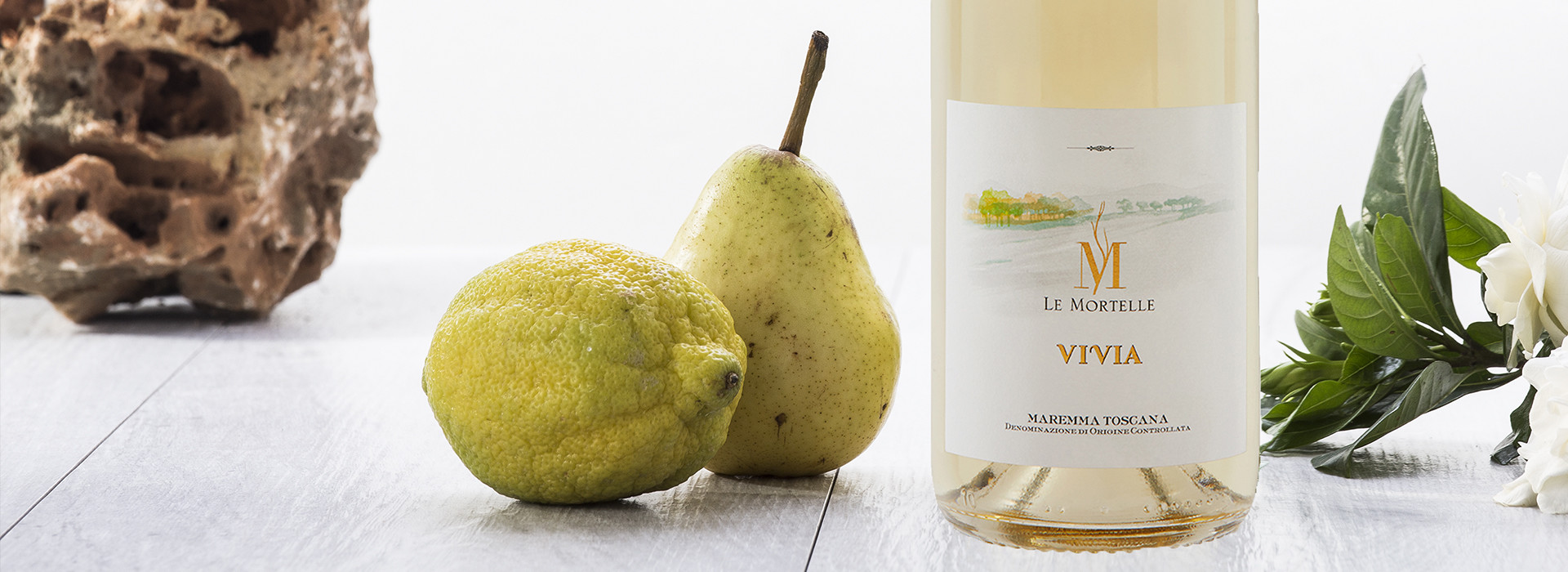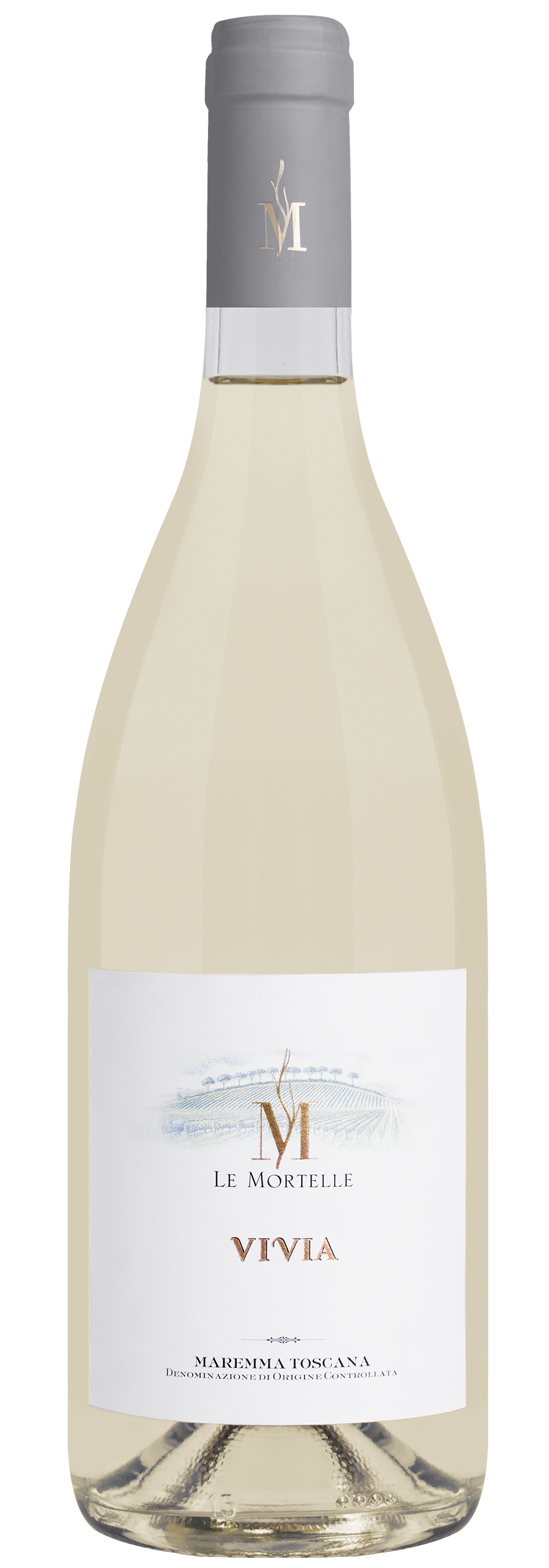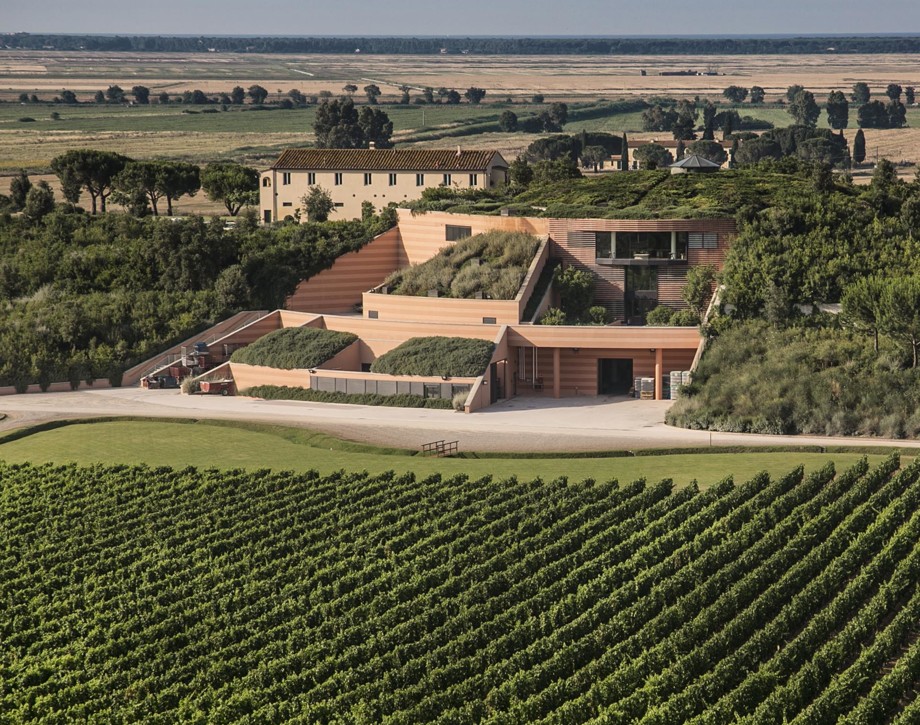Vivia

Climate
The 2019 growing season began with mild winter weather and average rainfall, continued with warmer temperatures at the beginning of spring and was followed by a significant drop in temperature during the month of May. These climatic conditions delayed bloom and slowed down vine development. Summer weather was hot with a few heat spikes and light rain during the month of August. Selective grapevine defoliation and cluster thinning combined with a later harvest allowed the grapes to ripen slowly under optimal conditions. Harvesting operations began the first week of September with Voignier, full of aromas of ripe fruit, and continued mid-September with Vermentino, marked by citrusy fragrances. Ansonica was the last variety to be harvested at the beginning of October whose grapes gave structure and fragrance to the wine.
Vinification
Upon arrival in the cellar, the grapes were gently pressed and each grape variety was fermented separately to accentuate their unique characteristics. The must was cooled down to a controlled temperature of 10 °C (50 °F) for 24 hours to favor a natural settling of the impurities. The clarified must was transferred to temperature controlled stainless steel tanks for alcoholic fermentation at 16 °C (61 °F). Vivia was aged on the lees for a short period in stainless steel tanks, approximately three months, before being bottled in January 2020.
Historical Data
The Mortelle estate is in the heart of Maremma in Tuscany, near the town of Castiglione della Pescaia set in an extraordinary and fascinating position both for the territory’s unparalleled natural beauty and its historical heritage and culture. The Antinori family has been part of this territory for generations. Evidence of ownership of land in this area is recorded on a property deed dated 1863. It states their ownership of Poggio Franco, one of the best vineyards on the estate, together with other parcels of land. Since 1999, when the property was acquired, the family has dedicated their efforts to improving the vineyards and building the new winery with the firm belief that this area, slowly emerging on the Italian viticultural horizon, has great potential for the production of high quality wines. Varieties grown in this area can fully express their own characteristics as well as the exceptional qualities of the terroir. The soil is of medium consistency, sandy and loamy composed of clay and silica and in some parts of the estate is rich in rocky deposits. Vermentino and Ansonica, typical grape varieties cultivated in Tuscany’s costal area, grow alongside Viognier, a vine that has recently been planted after years of patient research to produce an elegant white wine expressing the colors and aromas of the Maremma coastline.
Tasting Notes
Vivia 2019 is bright straw yellow in color with greenish hues. Its nose is intense and very pleasurable. Aromas of lemons and green apples blend together with hints of ripe pears and pineapples, creating a complex yet delicate bouquet complemented by sensations of aromatic herbs such as sage and rosemary. Vivia’s palate is fresh and creamy with a mineral finish and citrusy after-aromas of lemons and citron peel.

The Wine
This wine is harvested from vineyards indigenous to the Tuscan coast, a blend of Vermentino and Viognier and a small percentage of Ansonica: a successful result of patient research that produced an elegant white wine expressing the colors and aromas of the Maremma coastline.

Climate
The 2019 growing season began with mild winter weather and average rainfall, continued with warmer temperatures at the beginning of spring and was followed by a significant drop in temperature during the month of May. These climatic conditions delayed bloom and slowed down vine development. Summer weather was hot with a few heat spikes and light rain during the month of August. Selective grapevine defoliation and cluster thinning combined with a later harvest allowed the grapes to ripen slowly under optimal conditions. Harvesting operations began the first week of September with Voignier, full of aromas of ripe fruit, and continued mid-September with Vermentino, marked by citrusy fragrances. Ansonica was the last variety to be harvested at the beginning of October whose grapes gave structure and fragrance to the wine.
Vinification
Upon arrival in the cellar, the grapes were gently pressed and each grape variety was fermented separately to accentuate their unique characteristics. The must was cooled down to a controlled temperature of 10 °C (50 °F) for 24 hours to favor a natural settling of the impurities. The clarified must was transferred to temperature controlled stainless steel tanks for alcoholic fermentation at 16 °C (61 °F). Vivia was aged on the lees for a short period in stainless steel tanks, approximately three months, before being bottled in January 2020.
Historical Data
The Mortelle estate is in the heart of Maremma in Tuscany, near the town of Castiglione della Pescaia set in an extraordinary and fascinating position both for the territory’s unparalleled natural beauty and its historical heritage and culture. The Antinori family has been part of this territory for generations. Evidence of ownership of land in this area is recorded on a property deed dated 1863. It states their ownership of Poggio Franco, one of the best vineyards on the estate, together with other parcels of land. Since 1999, when the property was acquired, the family has dedicated their efforts to improving the vineyards and building the new winery with the firm belief that this area, slowly emerging on the Italian viticultural horizon, has great potential for the production of high quality wines. Varieties grown in this area can fully express their own characteristics as well as the exceptional qualities of the terroir. The soil is of medium consistency, sandy and loamy composed of clay and silica and in some parts of the estate is rich in rocky deposits. Vermentino and Ansonica, typical grape varieties cultivated in Tuscany’s costal area, grow alongside Viognier, a vine that has recently been planted after years of patient research to produce an elegant white wine expressing the colors and aromas of the Maremma coastline.
Tasting Notes
Vivia 2019 is bright straw yellow in color with greenish hues. Its nose is intense and very pleasurable. Aromas of lemons and green apples blend together with hints of ripe pears and pineapples, creating a complex yet delicate bouquet complemented by sensations of aromatic herbs such as sage and rosemary. Vivia’s palate is fresh and creamy with a mineral finish and citrusy after-aromas of lemons and citron peel.

Fattoria Le Mortelle
The Mortelle estate is in the heart of Maremma in Tuscany, near the town of Castiglione della Pescaia set in an extraordinary and fascinating position both for the territory’s unparalleled natural beauty and its historical heritage and culture. The Antinori family has been part of this territory for generations. Evidence of ownership of land in this area is recorded on a property deed dated 1863. It states their ownership of Poggio Franco, one of the best vineyards on the estate, together with other parcels of land. Since 1999, when the property was acquired, the family has dedicated their efforts to improving the vineyards and building the new winery with the firm belief that this area, slowly emerging on the Italian viticultural horizon, has great potential for the production of high quality wines. Varieties grown in this area can fully express their own characteristics as well as the exceptional qualities of the terroir. The property extends over an area of 270 hectares (667 acres) 170 of which (420 acres) are planted with vineyards of Cabernet Sauvignon, Cabernet Franc and other more recently planted vineyards with white grape varieties such as Vermentino, Ansonica, Viognier and a small parcel of Carménère. The soil is of medium consistency, sandy and loamy composed of clay and silica and in some parts of the estate is rich in rocky deposits.

Soil
Loamy soil with sand and silt.
















